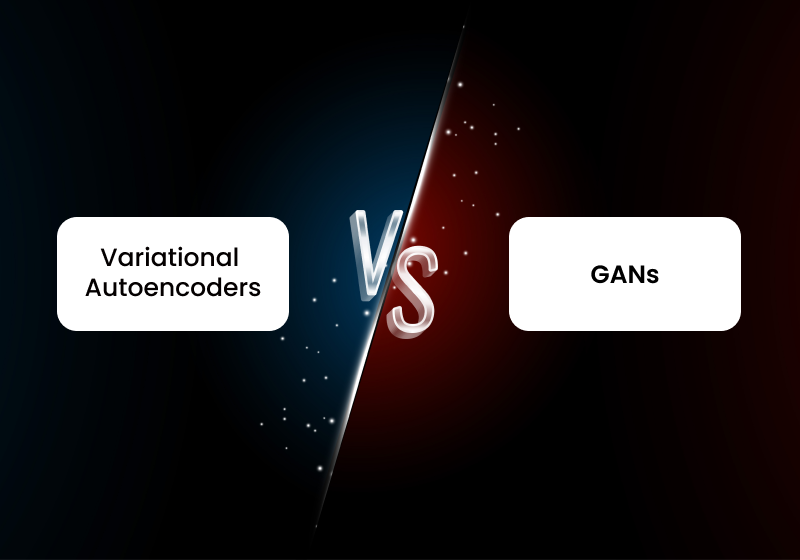
Variational Autoencoders (VAEs) and Generative Adversarial Networks (GANs) are both powerful models in unsupervised machine learning, especially for generating new data. While they share a similar goal of generating data that resembles real samples, they differ significantly in how they achieve this. Here’s a breakdown of what VAEs are, how they work, and the key differences between VAEs and GANs.
What is a VAE?
A Variational Autoencoder (VAE) is a type of generative model designed to learn the underlying patterns in data by encoding it into a compressed latent space and then decoding it back into its original form. It’s part of the autoencoder family but differs from traditional autoencoders by its probabilistic nature, which allows it to generate entirely new data rather than just reconstruct the original data.
How Does a VAE Work?
A VAE has three main components:
- Encoder: This part of the network compresses the input data into a latent space, a lower-dimensional space that captures the essential features of the data. The encoder doesn’t just produce a fixed representation but instead outputs two values: a mean and a standard deviation, which define a probability distribution for each input data point in the latent space.
- Latent Space Sampling: Once we have the mean and standard deviation from the encoder, the VAE samples a point from this latent space distribution. This sampling process introduces randomness, allowing the VAE to generate variations of the input data rather than exact copies.
- Decoder: The decoder takes the sampled point from the latent space and reconstructs the data from it. Since the latent space is probabilistic, each sample produces a unique variation of the data, enabling the VAE to generate new data points that resemble the original training data.
The key innovation in VAEs is this probabilistic framework, where the encoder learns a distribution rather than a fixed vector, and the decoder learns to generate samples based on these distributions.
Key Characteristics of VAEs
- Smooth Latent Space: VAEs create a smooth, continuous latent space, which means that small changes in the latent vector lead to small changes in the generated data. This quality is highly useful in applications like data interpolation, where we want gradual changes between samples.
- Probabilistic Approach: By learning a distribution rather than a fixed vector, VAEs encourage diversity in the generated outputs, making it possible to generate new data that still falls within the learned data distribution.
How Are VAEs Different from GANs?
Though both VAEs and GANs are generative models, they differ in the following ways:
| Aspect | VAE | GAN |
|---|---|---|
| Network Structure | Consists of an encoder-decoder pair, where the encoder compresses data, and the decoder reconstructs it. | Consists of two adversarial networks: a generator that produces data, and a discriminator that distinguishes between real and fake data. |
| Training Objective | Optimizes a reconstruction loss and KL divergence to balance between accurate reconstruction and smooth latent space. | Optimizes a minimax game between the generator and discriminator to make generated data indistinguishable from real data. |
| Latent Space | Probabilistic latent space with a smooth, continuous structure, enabling data sampling and interpolation. | No explicit latent space structure; focuses on generating realistic data without necessarily creating a smooth or continuous representation. |
| Diversity of Output | VAEs tend to produce more diverse outputs due to sampling from a probability distribution. | GANs can suffer from mode collapse, where the generator produces limited types of samples, reducing diversity in generated data. |
| Training Stability | More stable and easier to train, though outputs are generally less sharp and realistic than GAN outputs. | Training is often unstable due to the adversarial setup, but GANs can produce highly realistic and detailed outputs. |
| Applications | Used in data compression, anomaly detection, and generating diverse samples within the learned distribution. | Commonly used in image synthesis, video generation, and tasks that require very high-quality, realistic outputs. |
Practical Applications of VAEs vs. GANs
- VAEs are useful for applications that benefit from a smooth latent space, such as:
- Data Interpolation: Smoothly transitioning between different data points, such as generating intermediate images between two facial expressions.
- Anomaly Detection: Detecting outliers based on how well the model can reconstruct input data (poor reconstructions indicate anomalies).
- Variational Inference in Probabilistic Models: VAEs are rooted in probability theory, making them suitable for applications requiring probabilistic interpretations.
- GANs are popular in fields that require high-quality, photorealistic outputs:
- Image Generation: Creating lifelike images, often used in art, design, and media.
- Super-Resolution: Enhancing image resolution by generating high-definition versions of low-resolution images.
- Style Transfer: Transforming images from one style (e.g., sketches) to another (e.g., realistic photos).
Final Thoughts
Both VAEs and GANs have strengths and limitations depending on the use case. VAEs are more straightforward to train and can generate a smooth, interpretable latent space, which is ideal for applications that require controlled variability. GANs, on the other hand, are harder to train but can produce images and data that are incredibly close to real-life samples, making them powerful tools for media and entertainment applications.
